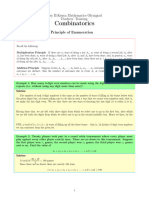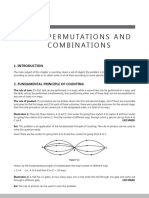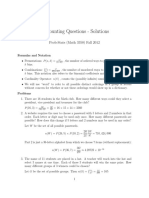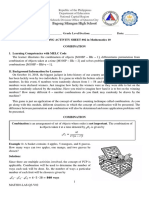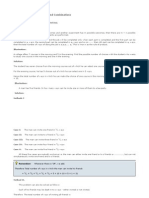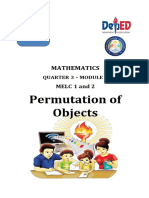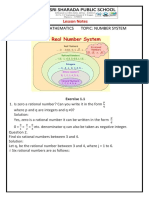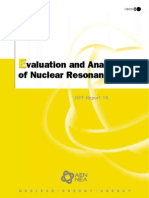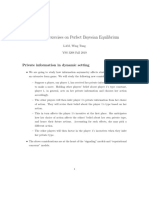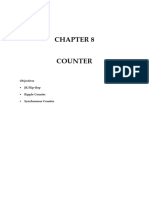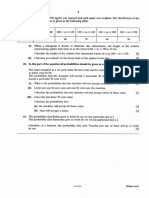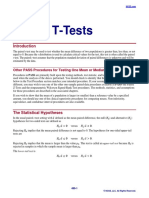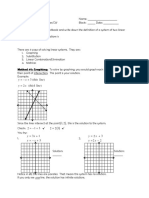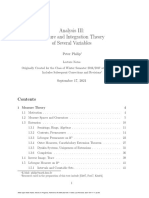Combinatorics: Applies To Whole Numbers, and N! Indicates That We Multiply Together All The Numbers
Combinatorics: Applies To Whole Numbers, and N! Indicates That We Multiply Together All The Numbers
Uploaded by
Sneha RCopyright:
Available Formats
Combinatorics: Applies To Whole Numbers, and N! Indicates That We Multiply Together All The Numbers
Combinatorics: Applies To Whole Numbers, and N! Indicates That We Multiply Together All The Numbers
Uploaded by
Sneha ROriginal Title
Copyright
Available Formats
Share this document
Did you find this document useful?
Is this content inappropriate?
Copyright:
Available Formats
Combinatorics: Applies To Whole Numbers, and N! Indicates That We Multiply Together All The Numbers
Combinatorics: Applies To Whole Numbers, and N! Indicates That We Multiply Together All The Numbers
Uploaded by
Sneha RCopyright:
Available Formats
Math 0993 / 1111 Learning Centre
Combinatorics
The field of combinatorics is the mathematics of counting. Combinatorics is used to
count large quantities of things in a systematic way, which is not an easy or trivial task.
Before describing the sorts of problems we face in combinatorics, we should define a
new mathematical symbol: n! We read this as “n factorial”. The factorial symbol only
applies to whole numbers, and n! indicates that we multiply together all the numbers
from n down to 1. So 4! = 4 × 3 × 2 × 1 = 24. We also define 0! = 1 because
combinatorics problems only work out correctly when we use this value.
An important skill in working with factorials is learning how to cancel them. Because
factorials count down to 1, when we divide factorials many of the factors can be
cancelled which simplifies the evaluation of the expression:
10! 10 9 8 7 6 5 4 3 2 1
= 10 × 9 × 8
7! 7 6 5 4 3 2 1
(n 2)! (n 2) (n 1) n (n 1) (n 2) 2 1
= (n + 2) × (n + 1)
n! n (n 1) (n 2) 2 1
n!
In general, for n > k: = n × (n − 1) × (n − 2) × … × (k + 1)
k!
PERMUTATIONS
A permutation is an arrangement of items, without any item repeating, where the order
of the items matters. Examples include the letters in a word, the digits in a number, or a
committee where everyone has a title (a president is different from a secretary or a
treasurer).
We can solve permutation problems using the “blanks” method. In this method we draw
a blank for every position we want to fill, then write how many ways each position can
be filled for every blank, and then multiply the resulting numbers together.
Example 1: How many five-letter sequences can be made from the letters P, Q, R, S
and T, without using any letter more than once?
Solution: This is a permutation, since the order of the letters matters. Since we are
making a five-letter sequence, we draw five blanks. There are five letters available to fill
the first blank, so we write “5” there. For the second blank, one letter is gone (though we
don’t know which one), and there are four left to pick from, so write “4” in the second
blank. If we continue with this logic, we get:
_5_ _4_ _3_ _2_ _1_
Now we multiply those numbers. 5 × 4 × 3 × 2 × 1 = 120. This is the answer.
© 2013 Vancouver Community College Learning Centre. AuthoredbybyEmily
Darren Rigby
Simpson
Student review only. May not be reproduced for classes.
Notice, too, that this is equal to 5 factorial. We write this as 5P5 = 5!, and in general
nPn = n!.
Example 2: How many three-letter sequences can be made from the letters P, Q, R, S
and T, without using any letter more than once?
Solution: We can use blanks here as well. We need a three-letter sequence, so we
write three blanks, and fill them with the number of letters that could go in each blank at
each stage of the problem:
_5_ _4_ _3_
We multiply the numbers: 5 × 4 × 3 = 60. We write this as 5P3 (out of 5 items, pick 3 of
them). The general form of this problem is:
n!
nPk = , where n ≥ k, and n, k are whole numbers.
(n k )!
We solve any permutation problem with identical items like this:
n!
The number of ways of arranging n items including k identical items is .
k!
Example 3: How many five-letter sequences can be made from the letters Q, Q, R, S
and T, without using any letter more than once?
Solution: This problem looks similar to Example 1, but now we have 2 Q’s. The Q’s
are identical, so the answer is 52 !! = 120 ÷ 2 = 60.
We can extend this idea to multiple sets of identical items. The number of five-digit
sequences we can make out of the digits 1, 1, 2, 2, 2 is 25! 3! ! = 120 ÷ (2 × 6) = 10. We
divide by 2! and 3! because we have a set of two identical 1’s and three identical 2’s.
COMBINATIONS
A combination is a collection of items where the order of the items does not matter.
Examples include cards in a poker or bridge hand (since the order the cards were dealt
to you is irrelevant in most card games), or a committee where no one has a title (either
a person is on the committee or not).
We write combinations in two ways. The number of ways of taking 3 items from a group
of 10 without order is either 10C3 or (103 ) , and both are read “10 choose 3”. It is important
to notice that (103 ) is not a fraction! The fraction 10∕3 is not a whole number, but 10-choose-
3 is the number of ways of doing something, and that must be a whole number.
We calculate combinations like this:
n n!
nCk = = , where n ≥ k, and n, k are whole numbers.
k k ! (n k )!
© 2013 Vancouver Community College Learning Centre.
Student review only. May not be reproduced for classes. 2
Example 4: How many ways can an organization with 10 people form (a) a four-
person committee? (b) a six-person committee?
Solution: This is a combination, since no one on the committee has a position.
10 ! 10 ! 10 9 8 7 6 ! 10 93 82 7
(a) 10C4 = = 10 × 3 × 7 = 210
4 ! (10 4)! 4 ! 6 ! 4! 6! 4 3 2 1
10 ! 10 !
(b) 10C6 = = 210
6 ! (10 6)! 4 ! 6 !
Notice that the two answers are the same. This is because we’re dividing the group of
10 into a group of 4 and a group of 6 either way.
Example 5: How many ways can 6 men and 4 women form a committee of 2 men and
2 women?
Solution: This sounds like a single combination problem, but it’s actually two: how
many ways can you choose 2 out of 6 men and then 2 out of 4 women? That’s 6C2 and
4C2, respectively, and we can make them into one answer by multiplying them. This idea
of putting pieces of combinatorics problems together with multiplication is called the
Fundamental Counting Principle: If there are n1 ways of doing a first step in a process,
and n2 ways of doing the second step, and so on, then the number of ways of doing the
whole process is n1 × n2 × …
6! 4!
So for our question, 6C2 × 4C2 = = 15 × 6 = 90
2! 4! 2! 2!
OTHER PROBLEMS
There are combinatorics problems that are neither permutations nor combinations. For
most of these, we can use the blanks method to get the answer.
Example 6: How many four-digit numbers can be made from the digits 0–9 if (a) the
digits may not be repeated and the number cannot start with 0? (b) any digit can be
repeated any number of times, and numbers can start with 0?
Solution: These may sound like permutation problems, but part (a) has a restriction
and part (b) allows you to reuse numbers. Neither of these problems can be solved
using the formulas presented in the section on permutations.
(a) We draw four blanks. There are ten digits, but the first blank can only have nine (the
0 is restricted). After that there are no restrictions, so the second blank has nine
possibilities, and so on. The answer is 9 × 9 × 8 × 7 = 4536. For this kind of problem,
deal with all restrictions first. You don’t have to fill in the blanks in order from left to right!
(b) We draw four blanks. For all four of them, all ten digits are available. The answer,
then, is 10 × 10 × 10 × 10 = 10,000. In this problem, each position in the number has
ten “states”. In general, whenever there are n things, each of which can be in k states
with repetition, there are kn possibilities.
© 2013 Vancouver Community College Learning Centre.
Student review only. May not be reproduced for classes. 3
EXERCISES
A. Simplify (but do not evaluate) these factorial expressions.
7! n! ( x 3 )! (k 1)!
1) 2) 3) 4)
3! (n 2)! ( x 1)! (k 1)!
B. Are these situations permutations, combinations or neither?
1) A child makes a stack out of five blocks which are all different colours.
2) A poker player is dealt five cards from a well-shuffled deck.
3) A cat taps on the keys of a piano, playing six notes.
4) A safe manufacturer chooses three distinct numbers to form a combination.
5) A person flips four different coins and looks to see whether they’re heads or tails.
C. Determine the number of possibilities in these permutation problems.
1) A valet parks 6 cars in the 6 spaces farthest from a restaurant.
2) A baseball coach decides in what order his 9 players will bat.
3) An official draws the names of a grand prize winner and a runner-up from a hat
containing 15 names.
4) A valet parks 6 cars in the 10 spaces farthest from a restaurant. [Hint: Empty
parking spaces are indistinguishable.]
D. Determine the number of possibilities in these combination problems.
1) A shopper takes 2 different flavours of chips from the 7 available in the store.
2) A captain chooses 4 teammates for dodgeball out of 8 players.
3) A customer orders a sundae by choosing 2 ice cream flavours out of 10 and 3
toppings out of 5.
E. Determine the number of possibilities in these problems.
1) The 10 students in a class each raise their hands or don’t when the teacher asks
a question.
2) A four-letter “word” is formed from the letters A, B, C, D and E, but the word
cannot start or end with the letter C. Letters may be repeated.
3) A four-letter “word” is formed from the letters A, B, C, D and E, but the word
cannot start or end with the letter C. Letters may not be repeated.
4) An three-digit area code is formed, where the first digit may not be 0 or 1, the
second digit must be 0 or 1, and the last digit may be anything.
SOLUTIONS
A. (1) 7 × 6 × 5 × 4 (2) n(n −1) (3) (x + 3)(x + 2) (4) (k + 1)k
B. (1) permutation (2) combination (3) neither (4) permutation (despite its name!)
(5) neither
C. (1) 6P6 = 720 (2) 9P9 = 362,880 (3) 15P2 = 210 (4) 10! / 4! = 151,200
D. (1) 7C2 = 21 (2) 8C4 = 70 (3) 10C2 × 5C3 = 450
E. (1) 210 = 1024 (2) 4 × 5 × 5 × 4 = 400 (3) 4 × 3 × 2 × 3 = 72 (4) 8 × 2 × 10 = 160
© 2013 Vancouver Community College Learning Centre.
Student review only. May not be reproduced for classes. 4
You might also like
- Module 1: COUNTING TECHNIQUESDocument12 pagesModule 1: COUNTING TECHNIQUESrinobiNo ratings yet
- ROTATIONAL MOTION@iitjeehelps PDFDocument124 pagesROTATIONAL MOTION@iitjeehelps PDFKmmsk nalkma100% (1)
- TK 3 5 PDFDocument47 pagesTK 3 5 PDFAyat HomanNo ratings yet
- 09.permutations and Combinations PDFDocument96 pages09.permutations and Combinations PDFNageswara Rao M100% (1)
- Techniques of Counting: Ms.M.BalamuraliDocument19 pagesTechniques of Counting: Ms.M.BalamuralifahadNo ratings yet
- Module 4Document12 pagesModule 4Mohieddine FaridNo ratings yet
- Unit 3 - Permutation and Combination: by Name of The Creator-Vikas Ranjan Designation - Trainer Department - CTLDDocument17 pagesUnit 3 - Permutation and Combination: by Name of The Creator-Vikas Ranjan Designation - Trainer Department - CTLDabhinav2610No ratings yet
- CLS ENG 24 25 XI Mat Target 3 Level 1 Chapter 8Document46 pagesCLS ENG 24 25 XI Mat Target 3 Level 1 Chapter 8BURST GamingNo ratings yet
- MFC1 Unit2 Part1 L1Document32 pagesMFC1 Unit2 Part1 L1nakhatebhavanaNo ratings yet
- MATH1081 Test 4 SolutionsDocument13 pagesMATH1081 Test 4 SolutionsIsha DeshmukhNo ratings yet
- Combinatorics 8 Solutions UHSMCDocument5 pagesCombinatorics 8 Solutions UHSMCWalker KroubalkianNo ratings yet
- KMO Training MainDocument14 pagesKMO Training Maindeonnjoroge23450No ratings yet
- Counting TechniquesDocument30 pagesCounting TechniquesathaliumarieNo ratings yet
- Permutation and Combination-1Document70 pagesPermutation and Combination-1Gaurav Tiwari100% (1)
- Mathematics Week 1 Third QuarterDocument4 pagesMathematics Week 1 Third Quartermaritope0404No ratings yet
- Permutation and Combination TheoryDocument31 pagesPermutation and Combination TheoryYash Raj100% (2)
- Math10 SLHT, q3, Wk3, M10sp-Iiic-1Document6 pagesMath10 SLHT, q3, Wk3, M10sp-Iiic-1Justiniano SalicioNo ratings yet
- Math10 - Q3Document28 pagesMath10 - Q3Anne GarciaNo ratings yet
- Math 465 - Introduction To Combinatorics Problem Set 1Document3 pagesMath 465 - Introduction To Combinatorics Problem Set 1Sid JhaNo ratings yet
- Permutations and CombinationsDocument65 pagesPermutations and Combinationsgilbertelena7898No ratings yet
- 50 Counting Questions - Solutions: Prob-Stats (Math 3350) Fall 2012Document10 pages50 Counting Questions - Solutions: Prob-Stats (Math 3350) Fall 2012Mohammad Haffiz AtingNo ratings yet
- #Topic 5 Relations, Mapping and FunctionsDocument7 pages#Topic 5 Relations, Mapping and FunctionsjamesbriandunguNo ratings yet
- Problems Involving CombinationDocument5 pagesProblems Involving Combinationbanot10262002No ratings yet
- Math10 Q3 Las V02Document7 pagesMath10 Q3 Las V02Mica Simbajon (micay)No ratings yet
- Family Materials 1Document5 pagesFamily Materials 1api-420503879No ratings yet
- 5 Permutaion CombinationDocument59 pages5 Permutaion Combinationaavneet21No ratings yet
- Mathematics 10 Learning Activity Sheet (LAS) : Quarter 3 - Week 2Document6 pagesMathematics 10 Learning Activity Sheet (LAS) : Quarter 3 - Week 2Mario CuadroNo ratings yet
- Written Report in ProbabilityDocument4 pagesWritten Report in ProbabilityAzel GantalaNo ratings yet
- CountingDocument8 pagesCountingnzoborNo ratings yet
- Module 6 Counting TechniquesDocument8 pagesModule 6 Counting TechniquesJr PrintingNo ratings yet
- Permutations and Combinations: Basic Principles of Counting Fundamental Principal of Counting Rule of ProductDocument19 pagesPermutations and Combinations: Basic Principles of Counting Fundamental Principal of Counting Rule of ProductVivek ReddyNo ratings yet
- Daily Lesson Plan: Basic Education Department Junior High SchoolDocument5 pagesDaily Lesson Plan: Basic Education Department Junior High SchoolKingErnie MenorNo ratings yet
- A4 - G10 - Q3 - Module 1 - MELC 1&2Document10 pagesA4 - G10 - Q3 - Module 1 - MELC 1&2Jayzi VicenteNo ratings yet
- QA SLM Math10Q3Mod1 Permutation John Rhey SisonDocument15 pagesQA SLM Math10Q3Mod1 Permutation John Rhey SisonJames Benedict IgamaNo ratings yet
- QA SLM Math10Q3Mod1 Permutation John Rhey Sison Merged 1 1Document51 pagesQA SLM Math10Q3Mod1 Permutation John Rhey Sison Merged 1 1Ran HaitaniNo ratings yet
- 13 Permutaion CombinationDocument58 pages13 Permutaion CombinationyeahbabyNo ratings yet
- Exam 1 SolutionsDocument4 pagesExam 1 SolutionsdungchungNo ratings yet
- Junior78 Nov8Document13 pagesJunior78 Nov8tumdeetNo ratings yet
- Questions On Permutations and CombinationsDocument11 pagesQuestions On Permutations and Combinationskraw2005sgnrNo ratings yet
- Counting TechniquesDocument52 pagesCounting TechniquesPranav DessaiNo ratings yet
- Probability and PermutationsDocument6 pagesProbability and PermutationsChai Kueh KhunNo ratings yet
- Bt0069 Smu Discrete MathematicsDocument268 pagesBt0069 Smu Discrete MathematicsSmruti Ranjan BeheraNo ratings yet
- 8 Combinations With Repetition 04-10-2024Document88 pages8 Combinations With Repetition 04-10-2024duttasmaranika106No ratings yet
- P and S Unit 1Document78 pagesP and S Unit 1Madhav ChNo ratings yet
- Illustration:: Fundamental Rules of CountingDocument8 pagesIllustration:: Fundamental Rules of CountingTariqul IslamNo ratings yet
- Grade 10 Task Sheet March 21 2024Document8 pagesGrade 10 Task Sheet March 21 2024christinamiller571No ratings yet
- PermutationsDocument110 pagesPermutationsASHISH YADAVNo ratings yet
- Mit18 05 s22 Exam01 SolDocument6 pagesMit18 05 s22 Exam01 Soltimur yasarNo ratings yet
- Grade 9 Number SystemDocument19 pagesGrade 9 Number SystemSwetha WariNo ratings yet
- 2013 Intermediate SolutionsDocument18 pages2013 Intermediate SolutionsViet Quoc HoangNo ratings yet
- Module 3 PDFDocument78 pagesModule 3 PDFFons Roxas-ChuaNo ratings yet
- HW1 Solution PDFDocument2 pagesHW1 Solution PDFClaude PepiNo ratings yet
- TCS Latest Pattern Questions With Explanations - 3Document5 pagesTCS Latest Pattern Questions With Explanations - 3Keerthana SubramanianNo ratings yet
- Counting RulesDocument5 pagesCounting RulesehllamaeescobarNo ratings yet
- IMC 2013 Web Solutions + SummaryDocument18 pagesIMC 2013 Web Solutions + SummaryBHAAJI0001No ratings yet
- CSE 312: Foundations of Computing II Combinatorics 1 SolutionsDocument4 pagesCSE 312: Foundations of Computing II Combinatorics 1 SolutionsfaisalNo ratings yet
- Mathematics: Quarter 3 - Module 1: PermutationsDocument30 pagesMathematics: Quarter 3 - Module 1: PermutationsTor PidNo ratings yet
- Grade 6 Math Circles March 9, 2011 CombinationsDocument5 pagesGrade 6 Math Circles March 9, 2011 CombinationsLlosemi LsNo ratings yet
- MIT6 042JF10 FinalDocument20 pagesMIT6 042JF10 FinalJ raNo ratings yet
- Lecture 6 Permutation and CombinationDocument7 pagesLecture 6 Permutation and Combinationrahman241abdurNo ratings yet
- Attacking Problems in Logarithms and Exponential FunctionsFrom EverandAttacking Problems in Logarithms and Exponential FunctionsRating: 5 out of 5 stars5/5 (1)
- PHSC 11 Marking Guideline-1Document7 pagesPHSC 11 Marking Guideline-1andrewmphela99No ratings yet
- Jeff 18Document126 pagesJeff 18larabellonoNo ratings yet
- Fix EmotesDocument4 pagesFix Emotesquevedofrancisco300No ratings yet
- Itae0044 Test 1Document32 pagesItae0044 Test 1Nageshwar SinghNo ratings yet
- Static Optimization: An Overview: Dr. Radhakant PadhiDocument42 pagesStatic Optimization: An Overview: Dr. Radhakant Padhimallesh.bollojuNo ratings yet
- Yelina Marin Study Two Influence of Apology in PerceptionsDocument12 pagesYelina Marin Study Two Influence of Apology in Perceptionspaul omondiNo ratings yet
- Perfect Bayesian Equilibrium Ver1.1Document9 pagesPerfect Bayesian Equilibrium Ver1.1benjim123No ratings yet
- P2 Flip FlopDocument15 pagesP2 Flip FlopRama AdifitraNo ratings yet
- Lampiran 6 Spss PrintDocument4 pagesLampiran 6 Spss PrintAlamiah, SKM., M.KesNo ratings yet
- Optimizing Rig SchedulingDocument15 pagesOptimizing Rig SchedulingdbudyNo ratings yet
- Syllabus & Datesheet - Grade 6-7 1Document4 pagesSyllabus & Datesheet - Grade 6-7 1aaima4973No ratings yet
- Linear Arrays Representation & Traversal Insertion Deletion Linear Search Bubble Sort Binary SearchDocument18 pagesLinear Arrays Representation & Traversal Insertion Deletion Linear Search Bubble Sort Binary SearchAnanth KallamNo ratings yet
- QEE ProblemsDocument9 pagesQEE ProblemsMayank VatsaNo ratings yet
- History of Laplace TransformDocument4 pagesHistory of Laplace Transformnishagoyal100% (2)
- IMO Shortlist 1994: AlgebraDocument5 pagesIMO Shortlist 1994: Algebraquaned2k5No ratings yet
- Plotting Likert and Other Rating ScalesDocument9 pagesPlotting Likert and Other Rating ScalesEverett MillerNo ratings yet
- MATH Q1 Lesson 3 Place Value and Value of A Digit in Numbers Up To 100 000Document14 pagesMATH Q1 Lesson 3 Place Value and Value of A Digit in Numbers Up To 100 000Maribel LegondoNo ratings yet
- 4-Digit by 2-Digit Multiplication (A)Document20 pages4-Digit by 2-Digit Multiplication (A)Intan Baiduri100% (1)
- Step 1: Generate/Run The Results For The Fixed Effects RegressionDocument4 pagesStep 1: Generate/Run The Results For The Fixed Effects RegressionJaena RelleveNo ratings yet
- Chapter 8 - CounterDocument27 pagesChapter 8 - CounterjuNo ratings yet
- O Level Gen Math StatisticsDocument93 pagesO Level Gen Math StatisticsBharatonNo ratings yet
- Paired T-Tests: Other PASS Procedures For Testing One Mean or Median From Paired DataDocument13 pagesPaired T-Tests: Other PASS Procedures For Testing One Mean or Median From Paired Datajay SinghNo ratings yet
- Linear Systems Review Notes-CWDocument4 pagesLinear Systems Review Notes-CWJason NappierNo ratings yet
- Final Manuscript - 230122 - 142504Document17 pagesFinal Manuscript - 230122 - 142504hadiNo ratings yet
- MCQs - CompiledDocument11 pagesMCQs - Compiledfahadkhanffc100% (1)
- Analysis III: Measure and Integration Theory of Several Variables (Lecture Notes) - Peter PhilipDocument201 pagesAnalysis III: Measure and Integration Theory of Several Variables (Lecture Notes) - Peter Philipvic1234059No ratings yet
- Business Process Reengineering Using Six Sigma: Abella, Vanessa Balanag, Julie Anne Mojal-Amarillo, Mary Leonite MGT 201Document79 pagesBusiness Process Reengineering Using Six Sigma: Abella, Vanessa Balanag, Julie Anne Mojal-Amarillo, Mary Leonite MGT 201Weng Torres Allon100% (1)
- Working With Integers: Using Mathematics: Real-Life ApplicationsDocument12 pagesWorking With Integers: Using Mathematics: Real-Life ApplicationsMohd UvaisNo ratings yet












